Submissions: 2022 September
-
david.m.norris
- Asternaut
- Posts: 1
- Joined: Wed Sep 28, 2022 10:12 pm
Re: Submissions: 2022 September
Submission for APOD by David M. Norris
The Great Andromeda Galaxy (M31) is the nearest spiral galaxy to our own with diameter of about 220,000 light-years and is approximately 2.5 million light-years from Earth with an estimated one trillion stars. Andromeda is the nearest large galaxy to the Milky Way. The galaxy's name stems from the area of Earth's sky in which it appears, the constellation of Andromeda.
Visible as a faint smudge on moonless nights, it is one of the farthest objects visible to the naked eye. Like the Milky Way, the Andromeda Galaxy has satellite galaxies. Two of the brightest, M32 and M110, can easily be seen in this image on either side of the core of Andromeda.
The Milky Way and Andromeda galaxies are expected to collide in around 4–5 billion years, merging to form a giant elliptical galaxy. The fate of our Solar System in such a collision is currently unknown. If the galaxies do not merge, the Solar System could be ejected from the Milky Way, or even join Andromeda!
Integration: 83 x 180s lights, 20 darks, 30 flats, 30 bias.
Telescope: Askar FRA400 72mm f/5.6 Quintuplet Petzval Flat-Field Astrograph
Camera: ZWO ASI2600MC Pro APS-C CMOS Color Cooled Astronomy Camera
Mount: iOptron HEM27
Filter: Optolong L-Pro Deep Sky Filter
Accessories: ZWO ASIAIR Plus, ZWO EAF
Software: PixInsight, Photoshop
Guiding Telescope: William Optics 50mm UniGuide
Guiding Camera: ZWO ASI290MM Mini
Polar Alignment: iPolar
Bortle Class: 5
Integration: PixInsight
Post processing: PixInsight, Photoshop
Captured Sep 23, 24 2022 by David M. Norris
Full Resolution at Astrobin: https://astrob.in/pdwup3/0/
The Great Andromeda Galaxy (M31) is the nearest spiral galaxy to our own with diameter of about 220,000 light-years and is approximately 2.5 million light-years from Earth with an estimated one trillion stars. Andromeda is the nearest large galaxy to the Milky Way. The galaxy's name stems from the area of Earth's sky in which it appears, the constellation of Andromeda.
Visible as a faint smudge on moonless nights, it is one of the farthest objects visible to the naked eye. Like the Milky Way, the Andromeda Galaxy has satellite galaxies. Two of the brightest, M32 and M110, can easily be seen in this image on either side of the core of Andromeda.
The Milky Way and Andromeda galaxies are expected to collide in around 4–5 billion years, merging to form a giant elliptical galaxy. The fate of our Solar System in such a collision is currently unknown. If the galaxies do not merge, the Solar System could be ejected from the Milky Way, or even join Andromeda!
Integration: 83 x 180s lights, 20 darks, 30 flats, 30 bias.
Telescope: Askar FRA400 72mm f/5.6 Quintuplet Petzval Flat-Field Astrograph
Camera: ZWO ASI2600MC Pro APS-C CMOS Color Cooled Astronomy Camera
Mount: iOptron HEM27
Filter: Optolong L-Pro Deep Sky Filter
Accessories: ZWO ASIAIR Plus, ZWO EAF
Software: PixInsight, Photoshop
Guiding Telescope: William Optics 50mm UniGuide
Guiding Camera: ZWO ASI290MM Mini
Polar Alignment: iPolar
Bortle Class: 5
Integration: PixInsight
Post processing: PixInsight, Photoshop
Captured Sep 23, 24 2022 by David M. Norris
Full Resolution at Astrobin: https://astrob.in/pdwup3/0/
Re: Submissions: 2022 September
A shot in a million...
The great andromeda galaxy with a perseid meteor.
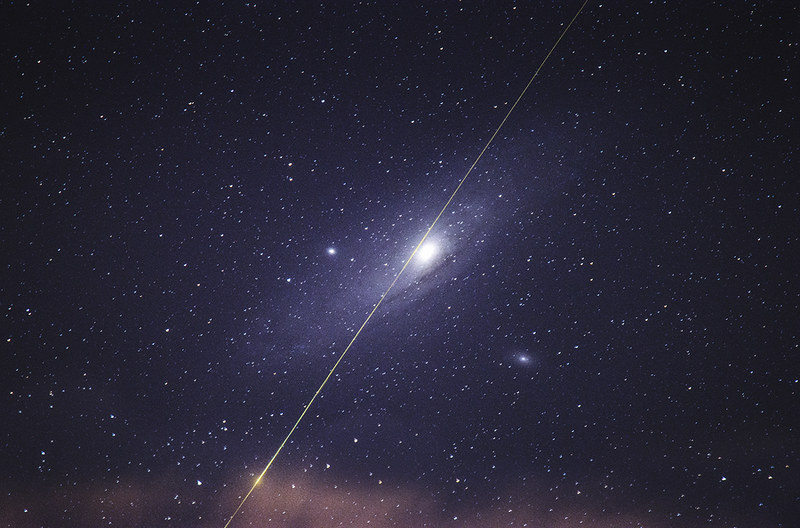 I shot in a million
I shot in a million
Camera: Nikon D850
Lens: sigma 150-600
Exif: f/6.3, 118s, iso 3200.
Location: Guatape, Colombia
The great andromeda galaxy with a perseid meteor.
 I shot in a million
I shot in a millionCamera: Nikon D850
Lens: sigma 150-600
Exif: f/6.3, 118s, iso 3200.
Location: Guatape, Colombia
-
Robservatory
- Ensign
- Posts: 28
- Joined: Thu Jul 28, 2022 3:26 pm
Re: Submissions: 2022 September
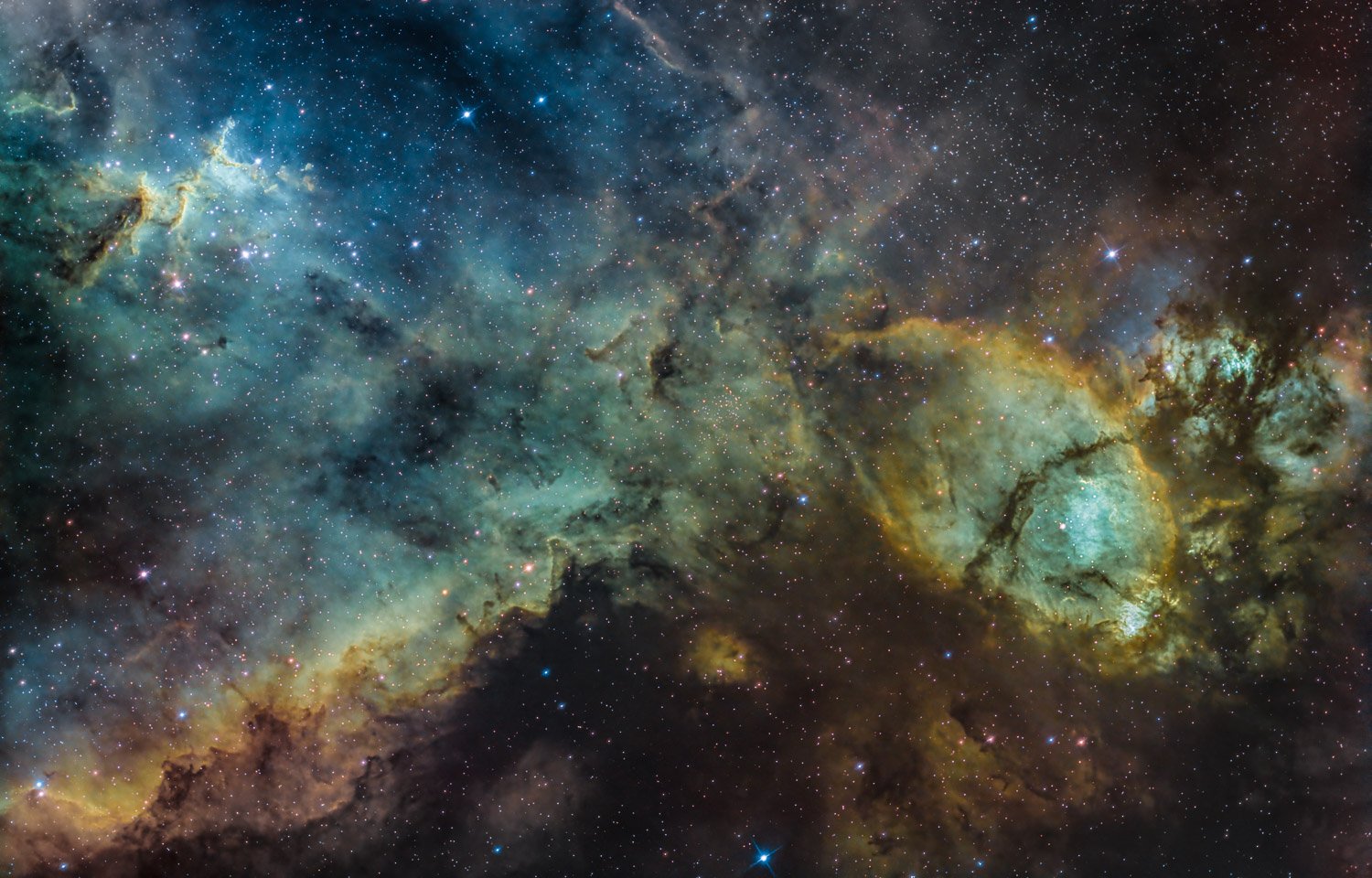
The remarkable Fish Head Nebula and Melotte 15 star forming region within the Heart Nebula. This is the first light image from my new Sky-Watcher Quattro 150P telescope shooting at F/3.45. It was also the first light for my new ZWO AM5 mount. So far, so good! Shot from downtown Vancouver, Bortle 8/9 zone.
Telescope: Sky-Watcher Quattro 150P
Camera: ASI 183MM Pro
Mount: ZWO AM5
Filters: Antlia 3nm Pro
Integration: 19.4 hours
Re: Submissions: 2022 September
Messier 45 and surrounding IFN
Camera: ZWO2600MC
Telescope: Sharpstar 61mm
Mount: SKywatcher AZGTI
Sub frames: 38x300s
Location: Cypress Hills, SK CA
Camera: ZWO2600MC
Telescope: Sharpstar 61mm
Mount: SKywatcher AZGTI
Sub frames: 38x300s
Location: Cypress Hills, SK CA
-
wrightdobbs
- Ensign
- Posts: 29
- Joined: Wed Jan 19, 2022 10:42 pm
Re: Submissions: 2022 September
"The Sun Illuminates the outflow from Major Hurricane Ian"
Sunset in the Panhandle of Florida in Tallahassee on September 27, 2022 brought both beauty and a scary harbinger of what was to come for fellow Floridians to our south. These upper level clouds, which traveled hundred of miles from where Hurricane Ian was located, were illuminated by the setting sun. The motion of the clouds is the outflow from powerful thunderstorms as Hurricane Ian continued its rapid intensification in the southeastern Gulf of Mexico. It would eventually make landfall in southern Florida about 18 hours after this photo was taken.
A panorama of several images at f/5.6, 1/250s, and ISO640 with Sony a7i and Sigma 35mm f/1.4 lens.
https://twitter.com/WrightDobbs
https://www.facebook.com/wrightdobbsphotography
https://instagram.com/wrightdobbs
Sunset in the Panhandle of Florida in Tallahassee on September 27, 2022 brought both beauty and a scary harbinger of what was to come for fellow Floridians to our south. These upper level clouds, which traveled hundred of miles from where Hurricane Ian was located, were illuminated by the setting sun. The motion of the clouds is the outflow from powerful thunderstorms as Hurricane Ian continued its rapid intensification in the southeastern Gulf of Mexico. It would eventually make landfall in southern Florida about 18 hours after this photo was taken.
A panorama of several images at f/5.6, 1/250s, and ISO640 with Sony a7i and Sigma 35mm f/1.4 lens.
https://twitter.com/WrightDobbs
https://www.facebook.com/wrightdobbsphotography
https://instagram.com/wrightdobbs
-
nazareno kurriger
- Ensign
- Posts: 19
- Joined: Mon Oct 12, 2020 2:22 pm
- carlos uriarte
- Ensign
- Posts: 38
- Joined: Sun Oct 13, 2019 6:17 pm
Re: Submissions: 2022 September
A bubble between clouds:
 NGC 7635: A bubble between clouds by Carlos Uriarte, en Flickr
NGC 7635: A bubble between clouds by Carlos Uriarte, en Flickr
My last image is a Bubble nebula (NGC 7635) with SHO narrowband channel and added RGB stars.
It is an emission nebula located in the constellation of Cassiopeia. The central bubble is one of three layers of hot gas surrounding the star SAO 20575, a very hot O6.5-class star. Curiously, this star (which is the one that heats the gas so that it emits light), due to its rapid movement, is not in the geometric center of the bubble. It is seen in the lower left area of the center of the bubble. It is a very young star (about 4 million years old...) and is expected to explode as a supernova in about 15 million years (more or less a million...). Interestingly, this nebula is located in a region where another supernova has already exploded.
It's great a lot of signal of SII, and aprecciate a large structures between bubble.
Tech data:
Halpha 25 of 900" astrodon 5nm
OIII 30 of 900" astrodon 5nm
SII 25 of 900" astrodon 5nm
RGB 25 each channel 120" astdodon
Telescope: Skywatcher Esprit 150
CCD: Atik 460ex
Mount: Paramount ME
 NGC 7635: A bubble between clouds by Carlos Uriarte, en Flickr
NGC 7635: A bubble between clouds by Carlos Uriarte, en FlickrMy last image is a Bubble nebula (NGC 7635) with SHO narrowband channel and added RGB stars.
It is an emission nebula located in the constellation of Cassiopeia. The central bubble is one of three layers of hot gas surrounding the star SAO 20575, a very hot O6.5-class star. Curiously, this star (which is the one that heats the gas so that it emits light), due to its rapid movement, is not in the geometric center of the bubble. It is seen in the lower left area of the center of the bubble. It is a very young star (about 4 million years old...) and is expected to explode as a supernova in about 15 million years (more or less a million...). Interestingly, this nebula is located in a region where another supernova has already exploded.
It's great a lot of signal of SII, and aprecciate a large structures between bubble.
Tech data:
Halpha 25 of 900" astrodon 5nm
OIII 30 of 900" astrodon 5nm
SII 25 of 900" astrodon 5nm
RGB 25 each channel 120" astdodon
Telescope: Skywatcher Esprit 150
CCD: Atik 460ex
Mount: Paramount ME
Re: Submissions: 2022 September
The Elephant Trunk nebula in pure LRGB.
This image was taken with my ASI533MM Pro, Orion f4 6" newt and ZWO LRGB filters.
This is approx 8 hrs worth of LRGB data. Bortle 5 sky, under 10% moon illumination.
Full resoltion: https://www.astrobin.com/pbcddv/
Instagram: https://www.instagram.com/colorado_astro/
Author: Tommy Lease
This image was taken with my ASI533MM Pro, Orion f4 6" newt and ZWO LRGB filters.
This is approx 8 hrs worth of LRGB data. Bortle 5 sky, under 10% moon illumination.
Full resoltion: https://www.astrobin.com/pbcddv/
Instagram: https://www.instagram.com/colorado_astro/
Author: Tommy Lease
-
Mathieu80
Re: Submissions: 2022 September
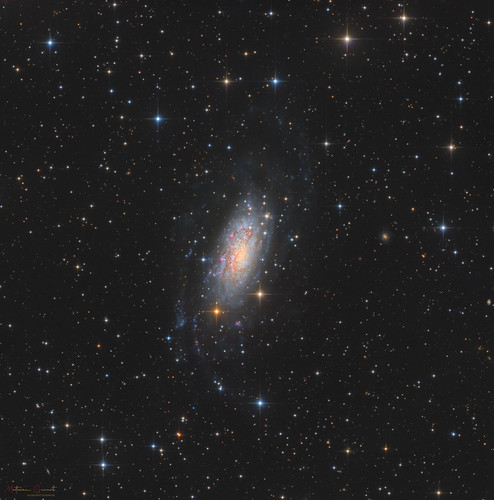 ngc3621 by Mathieu Guinot, sur Flickr
ngc3621 by Mathieu Guinot, sur FlickrNGC 3621 is a beautiful spiral galaxy located about 22 millions light-years away in the constellation of Hydra. Its morphological classification is SA(s)d, which indicates this is an ordinary spiral with loosely wound arms.
Like other spirals, it has a flat disc permeated by dark lanes of material and with prominent spiral arms where young stars are forming in clusters (the blue dots seen in the image). But while most spiral galaxies have a central bulge — a large group of old stars packed in a compact, spheroidal region — NGC 3621 doesn’t.NGC 3621 is also interesting as it is believed to have an active supermassive black hole at its centre that is engulfing matter and producing radiation. This is somewhat unusual because most of these so-called active galactic nuclei exist in galaxies with prominent bulges. In this particular case, the supermassive black hole is thought to have a relatively small mass, of around 20 000 times that of the Sun.Another interesting feature is that there are also thought to be two smaller black holes, with masses of a few thousand times that of the Sun, near the nucleus of the galaxy. Therefore, NGC 3621 is an extremely interesting object which, despite not having a central bulge, has a system of three black holes in its central region.
Data set from Telescope Live taken at El Sauce Observatory, Chile, from 2021/03/23 to 2022/04/24.
Telescope CDK 24
Camera FLI PL9000
L : 10×600″
R: 10×600″
G: 10×600″
B: 10×600″
Processed with Pixinsight & Photoshop
Copyright Mathieu Guinot & Telescope LiVe
-
Mathieu80
Re: Submissions: 2022 September
 IC5332 by Mathieu Guinot, sur Flickr
IC5332 by Mathieu Guinot, sur FlickrIC 5332, also known as PGC 71775, is an intermediate spiral galaxy about 30 million light-years away in the constellation Sculptor. This delicate spiral galaxy is viewed from Earth nearly face on and is beautifully symmetrical, and unusually faint with a very low surface brightness. It has a very small central bulge and open spiral arms accounting for its classification (SABc).
Data set from Telescope Live taken at El Sauce Observatory, Chile, from 2022/08/01 to 2022/09/23.
Telescope CDK24
Camera FLI PL9000
LRGB : 16/16/16/16 x 600s
Processed with Pixinsight & Photoshop
Copyright Mathieu Guinot & Telescope Live
-
Meiying Lee
- Ensign
- Posts: 66
- Joined: Sun Aug 15, 2021 8:28 am
Re: Submissions: 2022 September
Red Gradient Moon
Photo description:
After stacking the moon, which was taken continuously at 8-second intervals, the change in the color of the moon can be clearly seen. When the waxing crescent moon sets, the bright yellow moon surface gets closer to red. This is a phenomenon caused by atmospheric scattering.
Equipment Details:
Canon EOS 600D + SIGMA 60-600mm F4.5-6.3 S DG OS HSM Sports
Post-processing Details:
The moon is stacked together with the software Sequator156, which is shot continuously at 8-second intervals.
Time:7:40pm to 7:43 pm, Sep 29, 2022
Location : Taipei, Taiwan
photographer : Meiying Lee (李美英)
Photo description:
After stacking the moon, which was taken continuously at 8-second intervals, the change in the color of the moon can be clearly seen. When the waxing crescent moon sets, the bright yellow moon surface gets closer to red. This is a phenomenon caused by atmospheric scattering.
Equipment Details:
Canon EOS 600D + SIGMA 60-600mm F4.5-6.3 S DG OS HSM Sports
Post-processing Details:
The moon is stacked together with the software Sequator156, which is shot continuously at 8-second intervals.
Time:7:40pm to 7:43 pm, Sep 29, 2022
Location : Taipei, Taiwan
photographer : Meiying Lee (李美英)
-
martinkonrat
- Ensign
- Posts: 39
- Joined: Sun Sep 11, 2022 12:53 pm
Re: Submissions: 2022 September

Orion Nebula and The Horsehead Nebula, wide field (5h38' version)
This region, like possibly many of you, is the reason why I started photographing the night sky.
One and a half years ago I took my first poor, noisy and undefined picture of this region, that was my
first astrophotography. Since then I never took the time and had the courage to try it again due to the fear of
a new frustration. Today I am proud of my result and so I share it with you.
Nebulae are clouds of dust and gas that represent either end or the beginning of a star’s life cycle.
Some are places where stars have died, others where stars are forming. The Orion Nebula is the latter.
At only 1,344 light-years away, in Orion (the Hunter) constelation, the Orion Nebula is the closest and one of the brightest nebulae
visible from Earth. This means it can be seen with the naked eye up to mid-March when viewed under
dark skies.
The Horsehead nebula is a dark nebula composed of interstellar dust that blocks starlight
as well as the ionized gasses which comprise IC434
(the bright red emission nebula that is the backdrop of the Horsehead Nebula).
The Flame Nebula on the left is a reflection nebula that is lit
by nearby Alnitak (one of Orion's three belt stars).
Technichal Info
169 x 120s frames for a total of 5h38' integration time.
🗓 September, 23rd. 2022
🕶 IDAS LPS-P3 filter
NGC 2903 in H-alpha and continuum light (final version)
NGC 2903 in H-alpha and continuum light (final version)
NGC 2903 is a barred spiral galaxy in constellation Leo.
The image is calculated with and without H-alpha information. By toggling between the two variants the correlation between HII gas clouds and bluish regions (containing young stars and also OIII gas) can be visualized.
Click on the animation for detailed information and full resolution pictures.
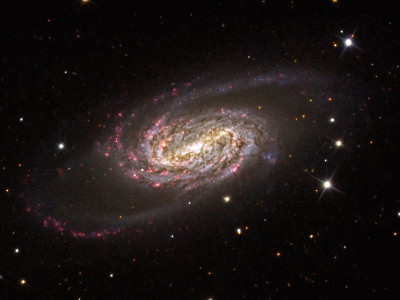
---
My Homepage
RSS news feed
NGC 2903 is a barred spiral galaxy in constellation Leo.
The image is calculated with and without H-alpha information. By toggling between the two variants the correlation between HII gas clouds and bluish regions (containing young stars and also OIII gas) can be visualized.
Click on the animation for detailed information and full resolution pictures.

---
My Homepage
RSS news feed
Last edited by stefanz on Sat Oct 01, 2022 10:14 am, edited 1 time in total.
M94 in H-alpha and continuum light (final version)
M94 in H-alpha and continuum light (final version)
M94 is a spiral galaxy in constellation Canes Venatici with two ring structures. The inner ring is an active star formation region and contains a lot of young blue stars and HII regions, the broader outer ring is very faint.
The image is calculated with and without H-alpha information. By toggling between the two variants the correlation between HII gas clouds and bluish regions (containing young stars and probably also OIII gas) can be visualized.
Click on the animation for detailed information and full resolution pictures.
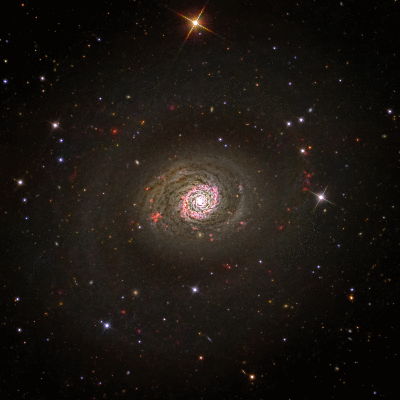
---
My Homepage
RSS news feed
M94 is a spiral galaxy in constellation Canes Venatici with two ring structures. The inner ring is an active star formation region and contains a lot of young blue stars and HII regions, the broader outer ring is very faint.
The image is calculated with and without H-alpha information. By toggling between the two variants the correlation between HII gas clouds and bluish regions (containing young stars and probably also OIII gas) can be visualized.
Click on the animation for detailed information and full resolution pictures.

---
My Homepage
RSS news feed
-
Mathieu80
Re: Submissions: 2022 September
 NGC247 LRGBHa by Mathieu Guinot, sur Flickr
NGC247 LRGBHa by Mathieu Guinot, sur FlickrNGC 247 (Caldwell 62, or the Claw Galaxy) is an intermediate spiral galaxy (although it is sometimes classified as a dwarf spiral galaxy) about 11.1 millions light-years away in the constellation Cetus.
NGC 247 has an unusually large void on one side of its spiral disk which contains some older, redder stars but no younger, bluer stars.
NGC 247 is one of several galaxies that is gravitationally bound to the Sculptor Galaxy (NGC 253). These galaxies form a small core in the center of the Sculptor group, which is one of the nearest groups of glaxies to the Milky Way. Most other galaxies associated with the Sculptor Group are only weakly gravitationally bound to this core.
Data set from Telescope Live taken at El Sauce Observatory, Chile, from 2022/07/26 to 2022/09/15.
Telescope CDK24
Camera FLI PL9000
LRGB : 16/16/17/18 x 600s
Processing Pixinsight & Photoshop
Credit : Mathieu Guinot & Telescope LIve
-
astrosirius
- Science Officer
- Posts: 117
- Joined: Fri Nov 23, 2012 11:17 am
- Location: Barcelona Spain
- Contact:
Re: Submissions: 2022 September
Lluís Romero Ventura
http://astrotolva.com/
http://astrotolva.com/
-
astrosirius
- Science Officer
- Posts: 117
- Joined: Fri Nov 23, 2012 11:17 am
- Location: Barcelona Spain
- Contact:
Re: Submissions: 2022 September
Lluís Romero Ventura
http://astrotolva.com/
http://astrotolva.com/
Re: Submissions: 2022 September
International Observe the Moon Night form Egypt
We observed the moon at our special sites from the Pyramids of Giza and the Sphinx Oct 1st 2022
1- The Great Sphinx of Giza and the Pyramid of Menkaure with the moon , pano of 85 mm
Gears:
Nikon Z6
Samyang 85mm
Exif:
Panorama 6 photos, 1/ 8 sec, Iso 640, f 3.5
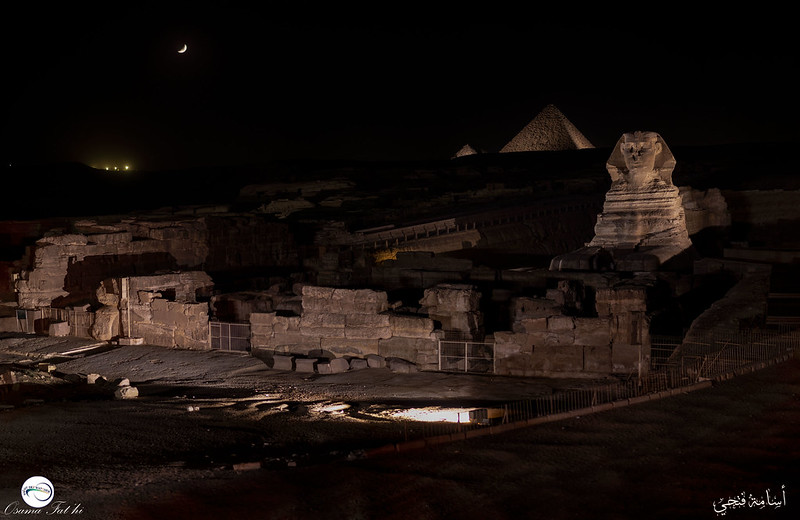 Moon-Pyramidand-sphinx- by osama Fathi, on Flickr
Moon-Pyramidand-sphinx- by osama Fathi, on Flickr
2-the Pyramid of Khafre,the pyramid of Menkuare and the Sphinx landscape tim-lapse
Gears:
Nikon Z6
Nikkor 14_24mm
Exif:
22 photos , 1/ 13 sec, Iso 640, f 2.8 at 24 mm
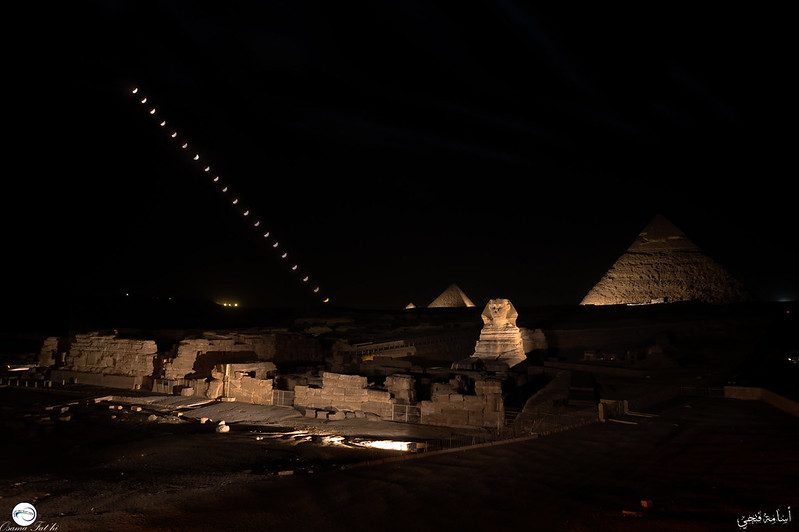 Pyramid-moon-time-lapse-landscape by osama Fathi, on Flickr
Pyramid-moon-time-lapse-landscape by osama Fathi, on Flickr
Credit
Osama Fathi
Social:
https://www.instagram.com/osama.fathi.nswatcher85/
https://www.facebook.com/NSWatcher/
We observed the moon at our special sites from the Pyramids of Giza and the Sphinx Oct 1st 2022
1- The Great Sphinx of Giza and the Pyramid of Menkaure with the moon , pano of 85 mm
Gears:
Nikon Z6
Samyang 85mm
Exif:
Panorama 6 photos, 1/ 8 sec, Iso 640, f 3.5
 Moon-Pyramidand-sphinx- by osama Fathi, on Flickr
Moon-Pyramidand-sphinx- by osama Fathi, on Flickr2-the Pyramid of Khafre,the pyramid of Menkuare and the Sphinx landscape tim-lapse
Gears:
Nikon Z6
Nikkor 14_24mm
Exif:
22 photos , 1/ 13 sec, Iso 640, f 2.8 at 24 mm
 Pyramid-moon-time-lapse-landscape by osama Fathi, on Flickr
Pyramid-moon-time-lapse-landscape by osama Fathi, on FlickrCredit
Osama Fathi
Social:
https://www.instagram.com/osama.fathi.nswatcher85/
https://www.facebook.com/NSWatcher/
-
Mathieu80
Re: Submissions: 2022 September
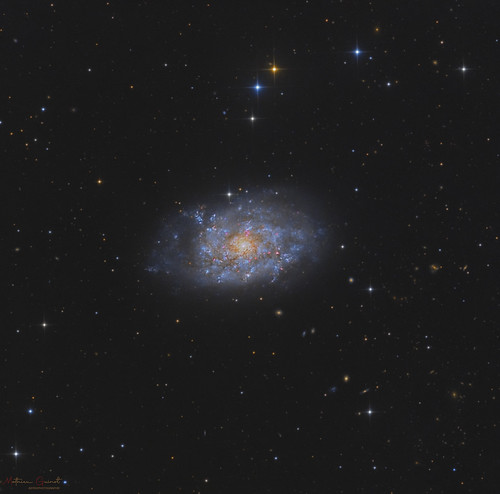 NGC7793 by Mathieu Guinot, sur Flickr
NGC7793 by Mathieu Guinot, sur FlickrNGC 7793 is a flocculent spiral galaxy located at a distance of 12.2 million light-years in the southern constellation of Sculptor. It is one of the five brightest galaxies within the Sculptor Group.
The morphological class of NGC 7793 is SA(s)d, indicating it is an unbarred spiral (SA) with no inner ring structure (s) and that the arms are loosely wound and disorganized (d). It is flocculent in appearance with a very small bulge and a star cluster at the nucleus. There are two nearby dwarf galaxy companions.
Data set from Telescope Live taken at El Sauce Observatory, Chile, from 2022/07/03 to 2022/09/27.
Telescope CDK24
Camera FLI PL9000
LRGB : 14/14/15/15 x 600s
Processed with Pixinsight & Photoshop
Credit : Mathieu Guinot & Telescope LIve
-
Mathieu80
Re: Submissions: 2022 September
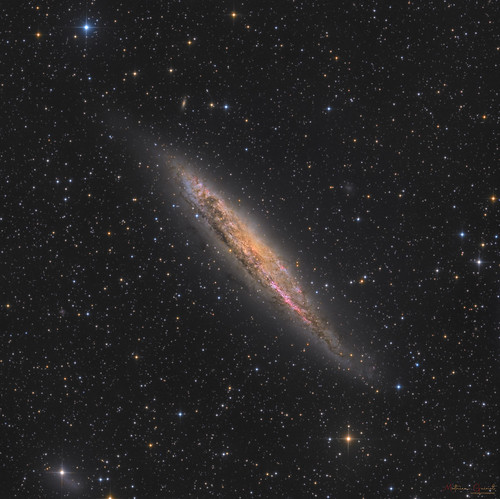 NGC4945 by Mathieu Guinot, sur Flickr
NGC4945 by Mathieu Guinot, sur FlickrThe beautiful NGC 4945 (also known as Caldwell 83) is a barred spiral galaxy located about 13 millions light-years away in the constellation Centaurus. It is almost the size of our own Milky Way galaxy, and it is one of the brightest galaxies of the Centaurus A/M83 group, a large and nearby group of galaxies.
NGC 4945 has an unusual energetic Seyfert 2 nucleus that might house a supermassive black hole. Around the nucleus, there is a dense disk of dust and gas, along with many dense star clusters.
Data set from Telescope Live taken at El Sauce Observatory from 2021/04/09 to 2022/04/01.
Telescope CDK24
Camera FLI PL9000
LRGB : 10/10/10/10 x 600s + 6/6/6/6x300s
Processed with Pixinsight & Photoshop
Credit : Mathieu Guinot & Telescope Live
Re: Submissions: 2022 September
International Observe the Moon Night form Egypt
We observed the moon at our special sites from the Pyramids of Giza and the Sphinx Oct 1st 2022
3-The great pyramid, the Pyramid of Khafre, the pyramid of Menkuare and the Sphinx
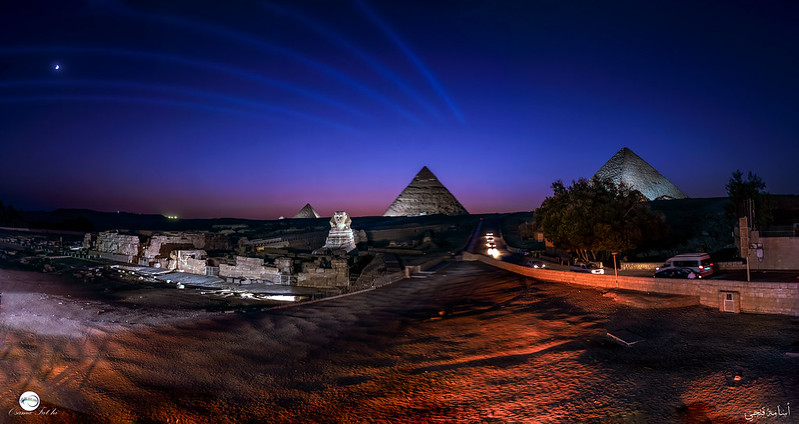 3-Pyramid-and-Sphinx-Pano-with-Moon2 by osama Fathi, on Flickr
3-Pyramid-and-Sphinx-Pano-with-Moon2 by osama Fathi, on Flickr
Gears:
Nikon Z6
Nikkor 14_24mm
Exif:
Panorama of 7 photos , 1/ 15 sec, Iso 640, f 2.8 at 24 mm
Credit
Osama Fathi
Social:
https://www.instagram.com/osama.fathi.nswatcher85/
https://www.facebook.com/NSWatcher/
We observed the moon at our special sites from the Pyramids of Giza and the Sphinx Oct 1st 2022
3-The great pyramid, the Pyramid of Khafre, the pyramid of Menkuare and the Sphinx
 3-Pyramid-and-Sphinx-Pano-with-Moon2 by osama Fathi, on Flickr
3-Pyramid-and-Sphinx-Pano-with-Moon2 by osama Fathi, on FlickrGears:
Nikon Z6
Nikkor 14_24mm
Exif:
Panorama of 7 photos , 1/ 15 sec, Iso 640, f 2.8 at 24 mm
Credit
Osama Fathi
Social:
https://www.instagram.com/osama.fathi.nswatcher85/
https://www.facebook.com/NSWatcher/




